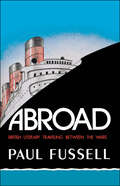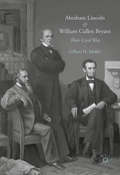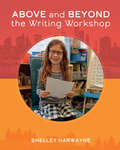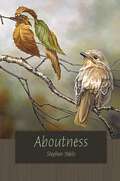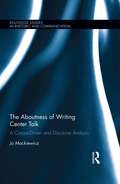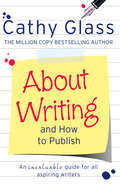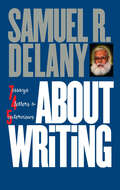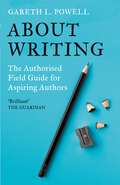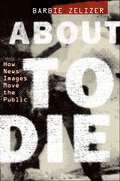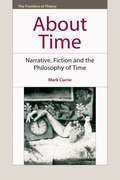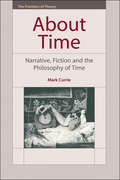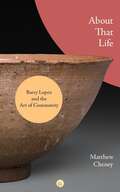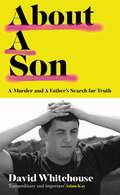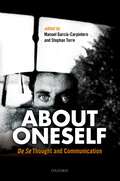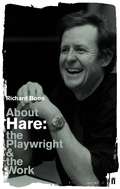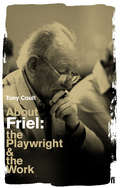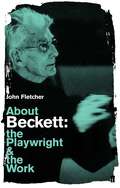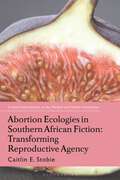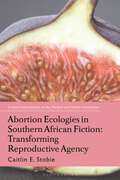- Table View
- List View
Abroad: British Literary Traveling between the Wars
by Paul FussellA book about the meaning of travel, about how important the topic has been for writers for two and a half centuries, and about how excellent the literature of travel happened to be in England and America in the 1920s and 30s.
Abraham Lincoln and William Cullen Bryant: Their Civil War
by Gilbert H. MullerThis definitive dual portrait offers a fresh perspective on Abraham Lincoln and William Cullen Bryant’s crucial role in elevating him to the presidency. The book also sheds new light on the influence that “Bryant and his class” (as Lincoln called the Radical Republican faction whose views Bryant articulated) wielded on the chief executive. How the cautious president and the preeminent editor of the Fourth Estate interacted—and how their ideological battle tilted gradually in Bryant’s favor—is the centerpiece of this study. A work of meticulous scholarship and a model of compression, Lincoln and Bryant is a watershed account of two Republicans fighting common enemies (and each other) during the Civil War era.
Abraham Lincoln and William Cullen Bryant: Their Civil War
by Gilbert H. MullerThis definitive dual portrait offers a fresh perspective on Abraham Lincoln and William Cullen Bryant’s crucial role in elevating him to the presidency. The book also sheds new light on the influence that “Bryant and his class” (as Lincoln called the Radical Republican faction whose views Bryant articulated) wielded on the chief executive. How the cautious president and the preeminent editor of the Fourth Estate interacted—and how their ideological battle tilted gradually in Bryant’s favor—is the centerpiece of this study. A work of meticulous scholarship and a model of compression, Lincoln and Bryant is a watershed account of two Republicans fighting common enemies (and each other) during the Civil War era.
Abraham Cowley: A Seventeenth-Century English Poet Recovered (Clemson University Press: Eighteenth-Century Moments)
Featuring nine chapters by a group of internationally renowned scholars, this book recovers Cowley’s unique achievement as a poet working across and between the genres and disciplines of his time and of our own. When Cowley died, he was the most famous poet in England, and his popularity continued throughout the eighteenth century; for instance, he was much more widely published than Donne, Herbert, Marvell, or Crashaw. Yet Cowley has virtually disappeared from the canon today, even from collections of metaphysical poetry, although it was Cowley who occasioned Samuel Johnson’s famous definition of metaphysical poetry in the first place. What circumstances led to Cowley’s sudden, precipitous fall? This book argues that Cowley’s initial popularity and later fall in reputation have a similar origin: the experimental qualities, and the range, of his poetry. Cowley’s works bridge disciplines (science, poetry), modes (prose, verse), and genres (lyric, ode, epic) in unexpected ways. The same mixed, eccentric, digressive, and unfinished qualities that endeared Cowley’s poetry to his contemporaries doomed his reputation for later readers unable to deal with his idiosyncratic style and defiance of recognized categories. Arguing that he mixed neoclassical and baroque, metaphysical and baroque, cavalier and metaphysical, poetry and prose, epic and history, science and verse, the contributors to this book reveal Cowley as a kaleidoscopic mind whose challenging writings fell between established categories and therefore fell through the cracks of literary history.
Above and Beyond the Writing Workshop
by Shelley HarwayneWhen writing workshops first blossomed in classrooms, its hallmarks were genuine curiosity, individual choice, quality conversations, and engaging children's literature. A joyous hum of intention, creativity, and craft enlivened the school day. Today's teachers are often faced with a range of obstacles, as new initiatives are embraced, mandates handed down, and scripted programs are purchased. Sometimes teachers must sacrifice the original principles of the writing workshop and lose the creative venue they provide. Above and Beyond the Writing Workshop is filled with original writing challenges designed to bring back the spirit of the original writing workshop model and encourage teachers to enhance it with invention, innovation, and inspiration. Teaching creative writing is not only possible, but an important process in their instruction. Author Shelley Harwayne invites teachers to keep the workshop spirit alive by: Encouraging professional conversations on classroom ideas and methods between colleagues; Developing writing cues that allow young writers to be inquisitive, outspoken, and independent; Showing how high quality writing can make a difference; Offering an inspired and stimulating outlet for students to express their passions. Harwayne's book will help teachers encourage students to write the world around them, which can generate more critical thinking and make for a more well-rounded child.
Above and Beyond the Writing Workshop
by Shelley HarwayneWhen writing workshops first blossomed in classrooms, its hallmarks were genuine curiosity, individual choice, quality conversations, and engaging children's literature. A joyous hum of intention, creativity, and craft enlivened the school day. Today's teachers are often faced with a range of obstacles, as new initiatives are embraced, mandates handed down, and scripted programs are purchased. Sometimes teachers must sacrifice the original principles of the writing workshop and lose the creative venue they provide. Above and Beyond the Writing Workshop is filled with original writing challenges designed to bring back the spirit of the original writing workshop model and encourage teachers to enhance it with invention, innovation, and inspiration. Teaching creative writing is not only possible, but an important process in their instruction. Author Shelley Harwayne invites teachers to keep the workshop spirit alive by: Encouraging professional conversations on classroom ideas and methods between colleagues; Developing writing cues that allow young writers to be inquisitive, outspoken, and independent; Showing how high quality writing can make a difference; Offering an inspired and stimulating outlet for students to express their passions. Harwayne's book will help teachers encourage students to write the world around them, which can generate more critical thinking and make for a more well-rounded child.
Aboutness (PDF)
by Stephen YabloAboutness has been studied from any number of angles. Brentano made it the defining feature of the mental. Phenomenologists try to pin down the aboutness-features of particular mental states. Materialists sometimes claim to have grounded aboutness in natural regularities. Attempts have even been made, in library science and information theory, to operationalize the notion. But it has played no real role in philosophical semantics. This is surprising; sentences have aboutness-properties if anything does. Aboutness is the first book to examine through a philosophical lens the role of subject matter in meaning. A long-standing tradition sees meaning as truth-conditions, to be specified by listing the scenarios in which a sentence is true. Nothing is said about the principle of selection--about what in a scenario gets it onto the list. Subject matter is the missing link here. A sentence is true because of how matters stand where its subject matter is concerned. Stephen Yablo maintains that this is not just a feature of subject matter, but its essence. One indicates what a sentence is about by mapping out logical space according to its changing ways of being true or false. The notion of content that results--directed content--is brought to bear on a range of philosophical topics, including ontology, verisimilitude, knowledge, loose talk, assertive content, and philosophical methodology. Written by one of today's leading philosophers, Aboutness represents a major advance in semantics and the philosophy of language.
The Aboutness of Writing Center Talk: A Corpus-Driven and Discourse Analysis (Routledge Studies in Rhetoric and Communication)
by Jo MackiewiczWriting centers in universities and colleges aim to help student writers develop practices that will make them better writers in the long term and that will improve their draft papers in the short term. The tutors who work in writing centers accomplish such goals through one-to-one talk about writing. This book analyzes the aboutness of writing center talk—what tutors and student writers talk about when they come together to talk about writing. By combining corpus-driven analysis to provide a quantitative, microlevel view of the subject matter and sociocultural discourse analysis to provide a qualitative macrolevel view of tutor-student writer interactions, it further establishes how these two research methods operate together to produce a robust and rigorous analysis of spoken discourse.
The Aboutness of Writing Center Talk: A Corpus-Driven and Discourse Analysis (Routledge Studies in Rhetoric and Communication)
by Jo MackiewiczWriting centers in universities and colleges aim to help student writers develop practices that will make them better writers in the long term and that will improve their draft papers in the short term. The tutors who work in writing centers accomplish such goals through one-to-one talk about writing. This book analyzes the aboutness of writing center talk—what tutors and student writers talk about when they come together to talk about writing. By combining corpus-driven analysis to provide a quantitative, microlevel view of the subject matter and sociocultural discourse analysis to provide a qualitative macrolevel view of tutor-student writer interactions, it further establishes how these two research methods operate together to produce a robust and rigorous analysis of spoken discourse.
Aboutness
by Stephen YabloAboutness has been studied from any number of angles. Brentano made it the defining feature of the mental. Phenomenologists try to pin down the aboutness-features of particular mental states. Materialists sometimes claim to have grounded aboutness in natural regularities. Attempts have even been made, in library science and information theory, to operationalize the notion. But it has played no real role in philosophical semantics. This is surprising; sentences have aboutness-properties if anything does. Aboutness is the first book to examine through a philosophical lens the role of subject matter in meaning. A long-standing tradition sees meaning as truth-conditions, to be specified by listing the scenarios in which a sentence is true. Nothing is said about the principle of selection--about what in a scenario gets it onto the list. Subject matter is the missing link here. A sentence is true because of how matters stand where its subject matter is concerned. Stephen Yablo maintains that this is not just a feature of subject matter, but its essence. One indicates what a sentence is about by mapping out logical space according to its changing ways of being true or false. The notion of content that results--directed content--is brought to bear on a range of philosophical topics, including ontology, verisimilitude, knowledge, loose talk, assertive content, and philosophical methodology. Written by one of today's leading philosophers, Aboutness represents a major advance in semantics and the philosophy of language.
About Writing and How to Publish
by Cathy GlassDrawing on years of experience, and thousands of readers comments and reviews of her writing, internationally bestselling author Cathy Glass provides a clear and concise, practical guide on writing and the best ways to get published.
About Writing: Seven Essays, Four Letters, & Five Interviews
by Samuel R. DelanyAward-winning novelist Samuel R. Delany has written a book for creative writers to place alongside E. M. Forster's Aspects of the Novel and Lajos Egri's Art of Dramatic Writing. Taking up specifics (When do flashbacks work, and when should you avoid them? How do you make characters both vivid and sympathetic?) and generalities (How are novels structured? How do writers establish serious literary reputations today?), Delany also examines the condition of the contemporary creative writer and how it differs from that of the writer in the years of Hemingway, Fitzgerald, and the high Modernists. Like a private writing tutorial, About Writing treats each topic with clarity and insight. Here is an indispensable companion for serious writers everywhere.
About Writing
by Gareth L. PowellGareth L. Powell would be the first to tell you that he doesn't know everything about being a writer, or about getting published, or about life when your work is in a bookshelf. But his field-guide to publishing, About Writing, is absolutely here to help writers on every stage of their journey.Whether you need a bit of writing inspiration or tips on how to find your voice, are struggling to manage writing alongside a day job, want some no-nonsense advice about working with an agent or a publisher or are all at sea with social media, this updated and expanded guide is a must have.Positive, blunt and refreshingly honest, this is a guide to the practical business of writing from a professional author with a decade's experience, who has navigated working with publishers of all sizes, and walked the path from debut to award-winner. Written with Gareth L. Powell's trademark warmth and wisdom, About Writing is here to help you achieve your goals, and write your own story.Originally published by Luna Press, this new edition contains updated tips, advice and information, plus more than 20,000 words of new material.
About to Die: How News Images Move the Public
by Barbie ZelizerDue to its ability to freeze a moment in time, the photo is a uniquely powerful device for ordering and understanding the world. But when an image depicts complex, ambiguous, or controversial events--terrorist attacks, wars, political assassinations--its ability to influence perception can prove deeply unsettling. Are we really seeing the world "as it is" or is the image a fabrication or projection? How do a photo's content and form shape a viewer's impressions? What do such images contribute to historical memory? About to Die focuses on one emotionally charged category of news photograph--depictions of individuals who are facing imminent death--as a prism for addressing such vital questions. Tracking events as wide-ranging as the 1906 San Francisco Earthquake, the Holocaust, the Vietnam War, and 9/11, Barbie Zelizer demonstrates that modes of journalistic depiction and the power of the image are immense cultural forces that are still far from understood. Through a survey of a century of photojournalism, including close analysis of over sixty photos, About to Die provides a framework and vocabulary for understanding the news imagery that so profoundly shapes our view of the world.
About to Die: How News Images Move the Public
by Barbie ZelizerDue to its ability to freeze a moment in time, the photo is a uniquely powerful device for ordering and understanding the world. But when an image depicts complex, ambiguous, or controversial events--terrorist attacks, wars, political assassinations--its ability to influence perception can prove deeply unsettling. Are we really seeing the world "as it is" or is the image a fabrication or projection? How do a photo's content and form shape a viewer's impressions? What do such images contribute to historical memory? About to Die focuses on one emotionally charged category of news photograph--depictions of individuals who are facing imminent death--as a prism for addressing such vital questions. Tracking events as wide-ranging as the 1906 San Francisco Earthquake, the Holocaust, the Vietnam War, and 9/11, Barbie Zelizer demonstrates that modes of journalistic depiction and the power of the image are immense cultural forces that are still far from understood. Through a survey of a century of photojournalism, including close analysis of over sixty photos, About to Die provides a framework and vocabulary for understanding the news imagery that so profoundly shapes our view of the world.
About Time: Narrative, Fiction and the Philosophy of Time
by Mark CurrieWhy have theorists approached narrative primarily as a form of retrospect? Mark Currie argues that anticipation and other forms of projection into the future are vital for an understanding of narrative and its effects in the world. In a series of arguments and readings, he offers an account of narrative as both anticipation and retrospection, linking fictional time experiments (in Ali Smith, Ian McEwan, Martin Amis and Graham Swift) to exhilarating philosophical themes about presence and futurity. This is an argument that shows that narrative lies at the heart of modern experiences of time, structuring the present, whether personal or collective, as the object of a future memory as much as it records the past.
About Time: Narrative, Fiction and the Philosophy of Time (The Frontiers of Theory)
by Mark CurrieWhy have theorists approached narrative primarily as a form of retrospect? Mark Currie argues that anticipation and other forms of projection into the future are vital for an understanding of narrative and its effects in the world.
About That Life: Barry Lopez and the Art of Community
by Matthew CheneyWhy write? Why ask a reader to give their time and attention to your words? How can writing be more than narcissism and self-aggrandizement? These questions were ones that the writer and naturalist Barry Lopez asked at the Bread Loaf Writers’ Conference in the summer of 2000, and they are questions at the heart of About That Life, a meditation on matters of living, making, and seeking. While Lopez is best known for such works of nonfiction as the National Book Award-winning Arctic Dreams, Matthew Cheney brings our attention to the many works of short fiction that Lopez published throughout his life, demonstrating how they fit within Lopez’s sense of ethical aesthetics. That sense is then set alongside the work of San Francisco’s New Narrative writers, insights from David Hinton’s translations of Tu Fu, the story of community arising around a pottery kiln in western Oregon, the beauties and contradictions of Sōetsu Yanagi’s The Unknown Craftsman, and the implications of the right-wing mob attack on the U.S. Capitol – an event that occurred on what would have been Barry Lopez’s 76th birthday. Through a collage of memoir, history, literary criticism, philosophy, aesthetic theory, and creative writing exercises, About That Life wonders how we might live and dream in a world that seems ever more cruel and destructive.
About A Son: A Murder and A Father’s Search for Truth
by David Whitehouse'The book that everyone will be talking about this year: a staggering work of honesty, empathy and humanity, wholly unlike anything else you will have read' Terri WhiteOn the evening of Halloween in 2015, Morgan Hehir was walking with friends close to Nuneaton town centre when they were viciously attacked by a group of strangers. Morgan was stabbed, and died hours later in hospital. He was twenty years old and loved making music with his band, going to the football with his mates, having a laugh; a talented graffiti artist who dreamed of moving away and building a life for himself by the sea.From the moment he heard the news, Morgan's father Colin Hehir began to keep an extraordinary diary. It became a record not only of the immediate aftermath of his son's murder, but also a chronicle of his family's evolving grief, the trial of Morgan's killers, and his personal fight to unravel the lies, mistakes and cover-ups that led to a young man with a history of violence being free to take Morgan's life that night.Inspired by this diary, About a Son is a unique and deeply moving exploration of love and loss and a groundbreaking work of creative non-fiction. Part true crime, part memoir, it tells the story of a shocking murder, the emotional repercussions, and the failures that enabled it to take place. It shows how grief affects and changes us, and asks what justice means if the truth is not heard. It asks what can be learned, and where we go from here.
About Oneself: De Se Thought and Communication
This volume addresses foundational issues concerning the nature of first-personal, or de se, thought and how such thoughts are communicated. One of the questions addressed is whether there is anything distinctive about first-person thought or whether it can be subsumed under broader phenomena. Many have held that first-person thought motivates a revision of traditional accounts of content or motivates positing special ways of accessing such contents. Gottlob Frege famously held that first-person thoughts involve a subject being 'presented to himself in a particular and primitive way, in which he is presented to no-one else.' However, as Frege also noted, this raises many puzzling questions when we consider how we are able to communicate such thoughts. Is there indeed something special about first-person thought such that it requires a primitive mode of presentation that cannot be grasped by others? If there really is something special about first-person thought, what happens when I communicate this thought to you? Do you come to believe the very thing that I believe? Or is my first-person belief only entertained by me? If it is only entertained by me, how does it relate to what you come to believe? It is these questions that the volume addresses and seeks to answer.
About Hare: The Playwright and the Work (About... The Playwrights And Their Works)
by Richard BoonThis series contains what no other study guides can offer - extensive first-hand interviews with the playwrights and their closest collaborators on all of their major work, put together by top academics especially for the modern student market. As well as invaluable synopses, biographical essays and chronologies, these guides allow the student much closer to the playwright than ever before!In About Hare, Professor Richard Boon provides an in-depth study of one of the great post-war British playwrights. His study includes a rigorous analysis of Hare's work, as well as interviews with Hare and those who helped to put his work on stage, including Bill Nighy, Vicki Mortimer, Sir Richard Eyre, Lia Williams and Jonathan Kent. With the increasing interest in this major playwright, whose work attracts the very best of acting talent, this book is a timely publication for student and theatregoer alike.
About Friel: The Playwright and the Work
by Tony CoultThis series contains what no other study guides can offer - extensive first-hand interviews with the playwrights and their closest collaborators on all of their major work, put together by top academics especially for the modern student market. As well as invaluable synopses, biographical essays and chronologies, these guides allow the student much closer to the playwright than ever before!In About Friel, teacher and playwright Tony Coult has selected an extensive and stimulating range of documents and interview material that explores Friel's life, work and the experiences of his collaborators and fellow artists who put that work on stage, including Patrick Mason, Connall Morrison, Joe Dowling and actors Catherine Byrne and Mark Lambert. If you want to read just one book on Brian Friel and the titanic power of his work, this is it.
About Beckett: The Playwright and the Work (About... The Playwrights And Their Works)
by John FletcherIn About Beckett Emeritus Professor John Fletcher has compiled a thorough and accessible volume that explains why Beckett's work is so significant and enduring. Professor Fletcher first met Beckett in 1961 and his book is filled not only with insights into the work but also interviews with Beckett and first-hand stories and observations by those who helped to put his work on the stage, including Dame Peggy Ashcroft, Roger Blin, Peter Hall, Max Wall and George Devine. As an introduction to Beckett and his work, Professor Fletcher's book is incomparable.
Abortion Ecologies in Southern African Fiction: Transforming Reproductive Agency (Critical Interventions in the Medical and Health Humanities)
by Caitlin E. StobieFocusing on texts from the late 1970s to the 1990s which document both changing attitudes to terminations of pregnancy and dramatic environmental, medical, and socio-political developments during southern Africa's liberation struggles, this book examines how four writers from Botswana, South Africa, and Zimbabwe address the ethics of abortion and reproductive choice.Viewing recent fiction through the lens of new materialist theory – which challenges conventional, individual-based notions of human rights by asserting that all matter holds agency – this book argues that southern African women writers anticipate and exceed current feminist revivals of materialist thought. Not only do the authors question contemporary discourse framing abortion as either a confirmation of a woman's 'right to choose' or an unethical termination of human life, but they challenge conventional understandings of development, growth, and time. Through close readings of both literal gestation in the selected texts and the metaphorical reproduction of the post/colonial nation, this study advances the concept of reproductive agency, creating a range of queer ecocritical alternatives to tropes such as those of 'the Mother Country', 'Mother Africa', or 'the birth of a nation'. This study situates abortion narratives by Wilma Stockenström (translated by J. M. Coetzee), Zoë Wicomb, Yvonne Vera, and Bessie Head alongside contemporary postcolonial feminist theories, melding traditional beliefs with materialist views to reconsider the future of reproductive health matters in southern Africa. Merging queer ecocritical perspectives from materialism and postcolonialism, this study will appeal to students and researchers in the medical humanities, new materialisms, and postcolonial studies.
Abortion Ecologies in Southern African Fiction: Transforming Reproductive Agency (Critical Interventions in the Medical and Health Humanities)
by Caitlin E. StobieFocusing on texts from the late 1970s to the 1990s which document both changing attitudes to terminations of pregnancy and dramatic environmental, medical, and socio-political developments during southern Africa's liberation struggles, this book examines how four writers from Botswana, South Africa, and Zimbabwe address the ethics of abortion and reproductive choice.Viewing recent fiction through the lens of new materialist theory – which challenges conventional, individual-based notions of human rights by asserting that all matter holds agency – this book argues that southern African women writers anticipate and exceed current feminist revivals of materialist thought. Not only do the authors question contemporary discourse framing abortion as either a confirmation of a woman's 'right to choose' or an unethical termination of human life, but they challenge conventional understandings of development, growth, and time. Through close readings of both literal gestation in the selected texts and the metaphorical reproduction of the post/colonial nation, this study advances the concept of reproductive agency, creating a range of queer ecocritical alternatives to tropes such as those of 'the Mother Country', 'Mother Africa', or 'the birth of a nation'. This study situates abortion narratives by Wilma Stockenström (translated by J. M. Coetzee), Zoë Wicomb, Yvonne Vera, and Bessie Head alongside contemporary postcolonial feminist theories, melding traditional beliefs with materialist views to reconsider the future of reproductive health matters in southern Africa. Merging queer ecocritical perspectives from materialism and postcolonialism, this study will appeal to students and researchers in the medical humanities, new materialisms, and postcolonial studies.
